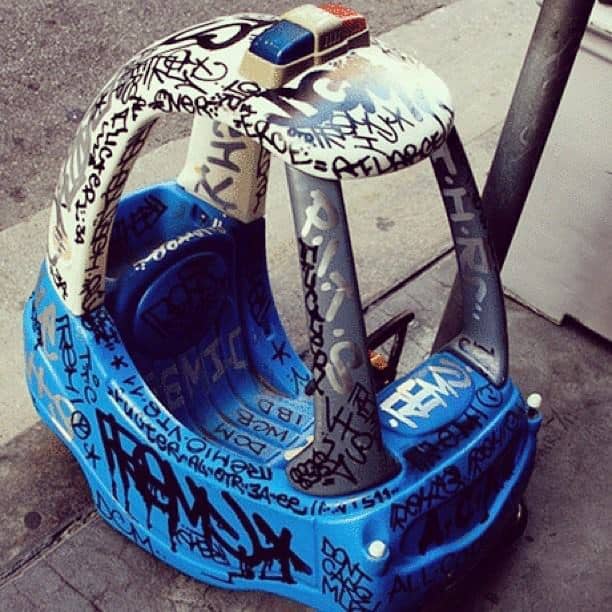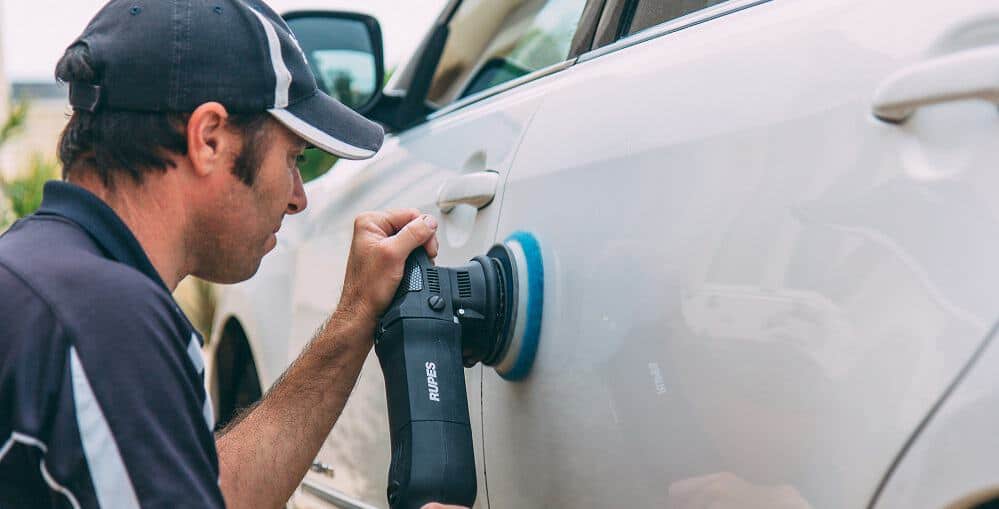For the average daily commuter, graffiti tends to be an entirely unpleasant, and completely unexpected surprise. An expletive enriched moment, where shock turns to panic, as you hastily ponder what to do, constantly fretting that by removing said pigment, you will somehow damage the clear coat or paint underneath. Sure, there are some pretty badass automotive graffiti projects out there, but these vehicles are few and far between.
Fortunately, those of you who have applied a nano ceramic coating to your vehicle’s exterior, are going to have one hell of a lot easier job than those who wrote the protectant off as “automotive snake oil.”
In today’s blog entry, we’ll review how a nano ceramic coating, like Armor Shield IX, protects against graffiti, markers, paint mishaps, and more. We’ll also explain some of the science behind this molecular magic, and how it makes the removal of graffiti a cinch.
Then, we’ll go over what products work best for graffiti removal, what to be wary of, and when it might be time to take the vehicle to a professional.
How Ceramic Coatings Work

If you are just getting into the nano ceramic protection game, or have been tinkering with these protective coatings for a while, and are still a tad fuzzy about exactly how they function on a molecular level, don’t fret.
Below you’ll find an abbreviated synopsis of how ceramic coating paint protection products work, along with a list of some of the key ingredients in AvalonKing’s industry-leading nano ceramic coating, Armor Shield IX.
You’ll also discover a few useful notes regarding what each product does, and how it helps make a nano ceramic coating develop its protective shell and function over the long run.
Ingredients Commonly Found in a Nano Ceramic Coating Product
- Nano SiO2: This is the magic mystery sauce that provides a ceramic coating with that super-hard, quartz-like layer of protection it requires. The SiO2 chemical abbreviation represents silica, or silicon dioxide, an odorless solid that is primarily composed of silicon and oxygen atoms, which in “nano form” measures less than 100 nanometers in size. Once blended with the appropriate bonding agents and hardeners, a ceramic coating’s SiO2 content helps form a matrix-like structure that is both extremely hard and slick.
- Nano TiO2: Titanium oxide/titanium dioxide (O2Ti or TiO2) can be found in all areas of daily life, including pharmaceutical products, glazes, enamels, antiseptics, and even toothpaste. In ceramic coatings, TiO2 helps improve hydrophobic water repelling capabilities, and makes for a slipperier, shinier surface. Rumor has it that Iron Man even uses it in the sack.
- Activation of Fluorine: The dust-repelling properties of a ceramic coating are often attributed to this ingredient, as it makes it difficult for airborne debris to stick to hard surfaces. This, in turn, keeps a vehicle cleaner for longer periods of time and far easier to decontaminate.
- Brightening Silicon Particles: All that shine and gloss has to come from somewhere, which is precisely what this ingredient does in a nano ceramic car coating product.
- Polysilazane: The chemical and temperature tolerance levels of this chemical compound are impressive to say the least. It is polysilazane in particular that is accredited for making a nano ceramic coating so resistant to things like graffiti and chemicals.
Consumer-Grade Ceramic Coatings vs. Paint, Markers, Oils, and Other Permanent Pigments

One of the most crucial things one must remember when dealing with ceramic coating products, is that not all ceramic coatings are created equal. As the recent head-to-head battle between Armor Shield IX vs Adam’s Polishes Graphene Ceramic Coating clearly illustrated, resiliency is oftentimes objective, especially when dealing with vandals with cans of spray paint, or even berry stains or bird droppings.
In all of these situations, the hydrophobic layer of protection provided by a quality, silica-rich ceramic coating will resist the contaminating chemicals in question, and cause them to harden atop its outer surface.

The reason for this, is because this protective layer keeps contaminants “suspended” above a surface. While a stripe of spray paint may require some serious scrubbing if allowed to bond with an unprotected layer of clear coat, it won’t require nearly as much elbow grease if the surface has been ceramic coated.
Even heavily layered graffiti will require little more than a spritz of bug and tar remover and a clean microfiber cloth, followed by a smidgeon of scrubbing in order to be lifted. In contrast, graffiti removal on an unprotected surface will likely involve things like various cutting compounds, power tools, and a hefty amount of prayer.
Removing Graffiti From a Car That’s Been Ceramic Coated

Unlike the act of removing a ceramic coating, getting an unsolicited stripe of spray paint, or a smudge of permanent marker off an automobile’s exterior should not require the use of power tools and polishing compounds. Hell, you might not even need to use a synthetic clay mitt, or some other form of clay decontamination media.
In most circumstances, if the vehicle has a healthy layer of 9H-strength ceramic coating in place, all you will need is a clean microfiber cloth, and a dash of bug and tar remover. It’s always a good idea to thoroughly decontaminate the area beforehand as well, using the two-bucket wash method, and combining it with a balanced, ceramic prep shampoo and a microfiber chenille wash mitt.
A quick isopropyl alcohol solution wipe-down afterward is never a bad idea either, as an IPA prep spray will guarantee that loose contaminants are not lingering on the surface.

As for the sudsy side of things, just wash the vehicle like you normally would, paying special attention to the types of surfaces where the unwanted pigment has been placed. Wash and dry complete, spritz the graffiti or “domestic incident” with some tar remover, wait a few seconds, and then buff the area with a multi-purpose microfiber cloth. This method will not remove a ceramic coating from a vehicle’s exterior, and does not require the use of a finishing polish.
Quick Tip: Since you will likely be working with a clear coated paint surface, thoroughly, and hastily removing the tar remover is crucial. The last thing anyone wants to see is their clear coat or ceramic coating bubbling-up because they allowed a harsh chemical cleaner to linger for too long.
Parting Shots

May it be the direct result of roving bands of vandals, rioting for all the wrong reasons, an accidental overspray during a DIY project, or a mischievous toddler with a permanent marker, graffiti is something you never want to see on your automobile.
However, few people ever consider graffiti as a genuine threat. The average car owner is far more interested in achieving a mirror-like shine from the cheapest, easiest-to-apply detailing solution available. They don’t give a fig about whether or not that weak-ass “ceramic product” has passed the standard test method for film hardness via a pencil scale. As long as that surface looks slick and shiny, all is right in the world…
Well we hate to break it to you buckos, but the world is a treacherous place, especially for our automobiles. Which is precisely why we came up with Armor Shield IX, and why DIY devotees can’t get enough of our ultra-easy and effective SiO2 Ceramic Booster Spray.
Finding the best way to protect a car’s paint at an affordable price is a constant balancing act, and here at AvalonKing, we do our damndest to walk that tightrope. A surface protectant should not break the bank, or your back, so hit us up if you agree, and let’s keep that graffiti at bay!












